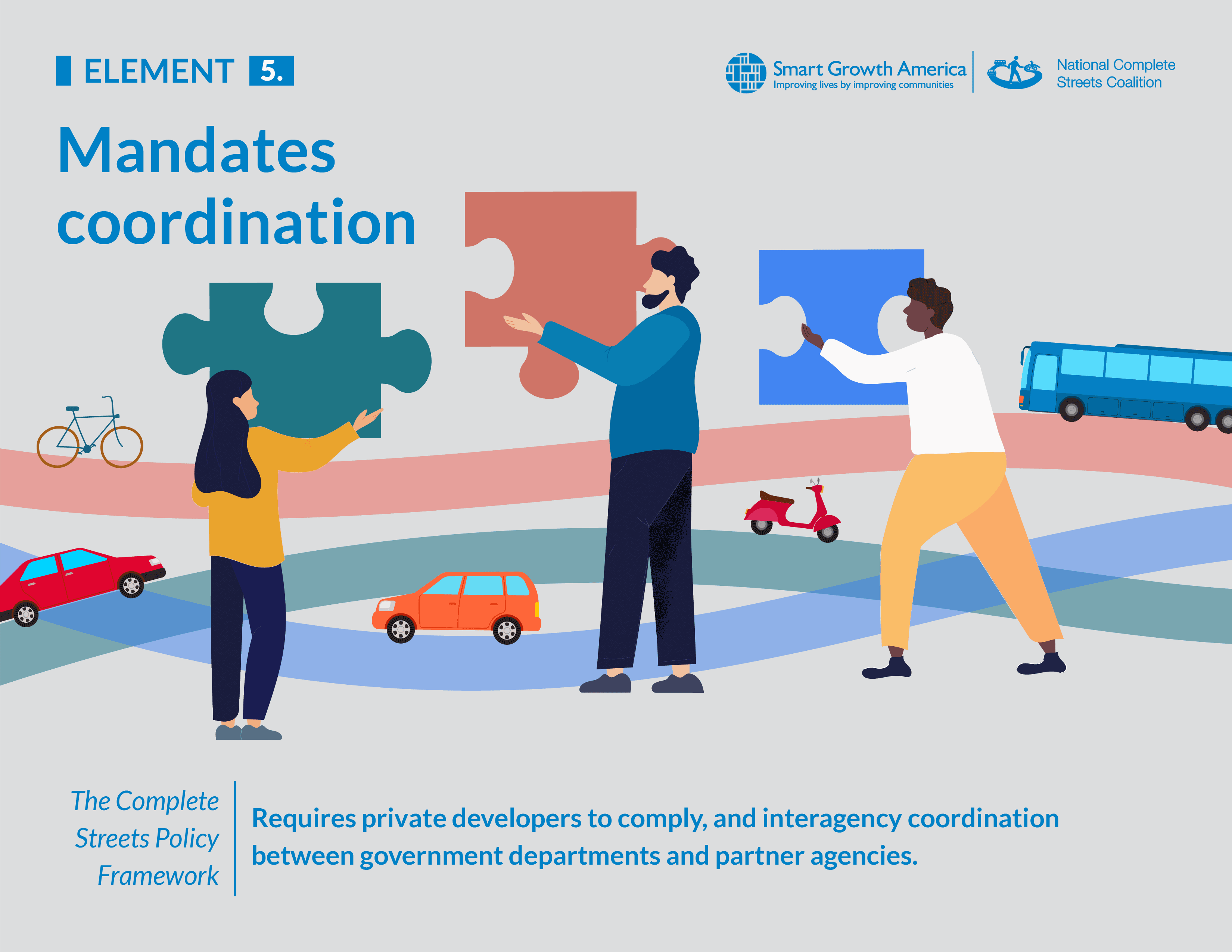
News
By Steve Davis, April 24, 2023
Any number of agencies—city, county, metro region, or state—may be responsible for the streets and sidewalks, often with overlapping authority. This is why the strongest Complete Streets policies clearly define who is responsible, what level of coordination is required, and even when or how outside parties must comply.

Why is this element integral to a strong Complete Streets policy?
While some streets have clear ownership by a single agency, it’s rarely that straightforward. For example, the state manages a street that’s intersected by city streets. What happens when new crosswalks are planned? Or you have a metro planning organization that doles out federal money to the city that actually owns and maintains the streets. Or a private developer who controls a portion of the sidewalk, or even a street through a new development surrounded by other city-owned streets.
These overlapping authorities can make it difficult to create a true network of Complete Streets rather than just a patchwork. But a strong policy will clearly define and regulate coordination and cooperation to ensure a Complete Streets approach is used on every project, especially when those projects cross or implicate multiple jurisdictions or agencies. As an example, San Jose’s (CA) policy says they will “work in coordination with other departments, agencies, and jurisdictions to maximize opportunities for Complete Streets, connectivity, and cooperation."
What does this element look like in practice?
There are really just two main components in the scoring for this element, depending on whether or not the policy is intensely local (city, county) or less so (state, metro), since a city has limited ability to dictate terms to their state DOT, though they can still establish their own commitment to coordination. At the local level, the focus is requiring private developers to comply with the Complete Streets policy to prevent gaps in the broader network of Complete Streets. For instance, in order for private developers to move forward with a zoning or building permit, they should also be required to address how they will incorporate Complete Streets into the project being reviewed, if applicable.
At the state and metro level, it’s largely about incentives within the policy to steer a greater share of that funding to projects that address the needs of all modes and users. States (and metro areas to a lesser degree) control the lion’s share of all federal transportation funding. And so a state- or metro-level policy gets all five points if the policy makes it clear that projects that account for the needs of all modes and users will be prioritized for funding. Often this happens by receiving extra weight in the scoring process to decide which projects are included in the state- or metro-level transportation plan. At the metro level, this is the Transportation Improvement Plan, which is a list of projects that are actually in the pipeline to receive funds and get built.
The second component for all policies is a requirement for agencies within a jurisdiction to coordinate and bring their other plans into alignment with the vision for building Complete Streets, like requiring a city’s zoning or housing department to coordinate with the transportation department. Every transportation problem is also a land-use issue, and vice versa, so requiring this coordination is vital for ensuring that the benefits of having safe streets for walking or biking are maximized by the land-use decisions on or near those streets.
Policy scoring details
The best Complete Streets policies clearly define the role and responsibility of each particular agency and require, rather than just encourage, cooperation and coordination. Using the right tool at the right scale ensures that agencies and jurisdictions use their resources effectively, minimizes opportunities for variances from the policy, and creates a framework for better decision-making amongst everybody involved. Doing this well also builds trust and the kinds of relationships that are essential to building a complete network.
In our framework for evaluating and scoring Complete Streets policies, this element is worth a total of 8 out of 100 possible points.
For municipality/county policies
- 5 points: Policy requires private development projects to comply.
- (2 points) A municipality’s or county’s policy mentions or encourages private development projects to follow a Complete Streets approach.
- (0 points) No mention.
For state/MPO policies
- 5 points: Policy clearly notes that projects that address how they will account for the needs of all modes and users are prioritized or awarded extra weight for funding and/or inclusion in Transportation Improvement Plans (TIPs).
- (2 points) The policy mentions or encourages projects receiving money passing through the agency to account for the needs of all modes and users.
- (0 points) No mention.
For all policies
- 3 points: Policy specifies a requirement for interagency coordination between various agencies such as public health, housing, planning, engineering, transportation, public works, city council, and/or mayor or executive office.
- (1 point) Policy mentions or encourages interagency coordination.
- (0 points) No mention.
Related News

© 2025 Smart Growth America. All rights reserved
Site By3Lane Marketing
























